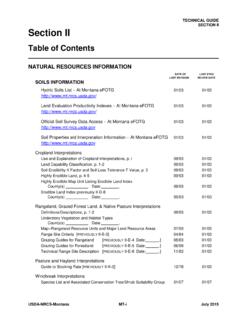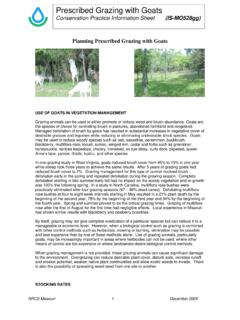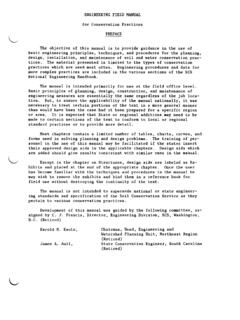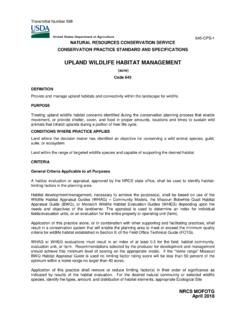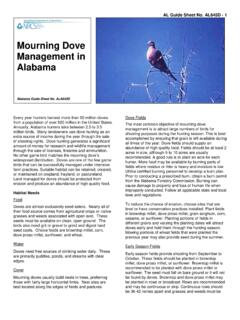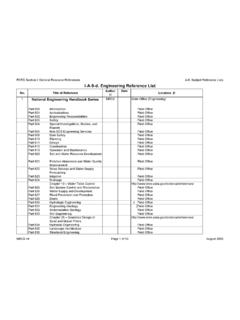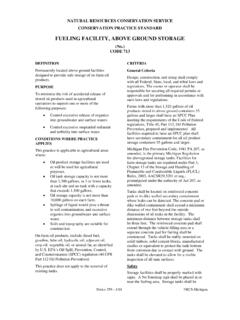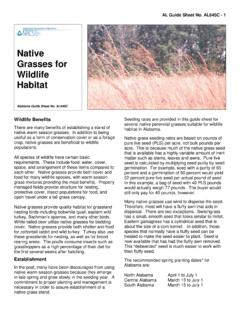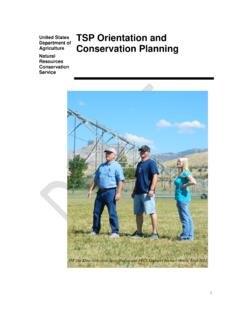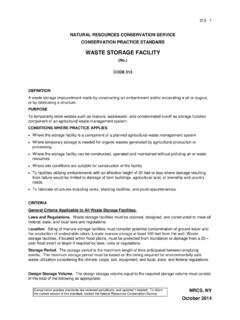Transcription of NATURAL RESOURCES CONSERVATION SERVICE
1 512 - 1 NATURAL RESOURCES CONSERVATION SERVICE CONSERVATION PRACTICE STANDARD FORAGE AND BIOMASS PLANTING (Acre) CODE 512 DEFINITION Establishing adapted and/or compatible species, varieties, or cultivars of herbaceous species suitable for pasture, hay, or biomass production. PURPOSES Improve or maintain livestock nutrition and/or health. Provide or increase forage supply during periods of low forage production. Reduce soil erosion. Improve soil and water quality. Produce feedstock for biofuel or energy production CONDITIONS WHERE PRACTICE APPLIES Practice applies on all lands suitable to the establishment of annual, biennial or perennial species for forage or biomass production.
2 The practice does not apply to the establishment of annually planted and harvested food, fiber, or oilseed crops. CRITERIA General Criteria Applicable to All Purposes Plant species and their cultivars shall be selected based upon: Climatic conditions, such as annual precipitation and distribution, growing season length, temperature extremes and the USDA Plant Hardiness Zones. Soil condition and landscape position attributes such as pH, available water holding capacity, aspect, slope, drainage class, fertility level, salinity, depth, flooding and ponding, and levels of phytotoxic elements that may be present. Resistance to disease and insects common to the site or location.
3 Compatibility with other forage species and their selected cultivar(s). Species will be suitable for the planned purpose. The long-term objectives of the land user will be used in selection of vegetative cover. Monocultures are discouraged. Introduction of invasive and noxious species is prohibited. The use of native species from local genotypes is encouraged. Specified seeding/plant material rates, methods of planting and date of planting shall be consistent with documented guidance cited by plant materials program, research institutions or agency demonstration trials for achieving satisfactory establishment. Seeding rates will be calculated on a pure live seed (PLS) basis.
4 Plant seeds to proper depth ensuring seed or planting will contact soil moisture uniformly. Prepare site to provide a medium that does not restrict plant emergence. All seed and planting materials shall meet state quality standards. Select plants that according to federal, state, or local regulations are not considered noxious or invasive species. Apply all plant nutrients and/or soil amendments for establishment purposes according to a current soil test. Application shall be appropriately placed and timed to be effective. NRCS, ILLINOIS April, 2015 CONSERVATION practice standards are reviewed periodically, and updated if needed. To obtain the current version of this, contact the NATURAL RESOURCES CONSERVATION .
5 512-2 If needed, legume seed shall be inoculated with the proper species of viable Rhizobia before planting. Pre-inoculated seed, determine pure live seed percentage from seed tags calibrate planting equipment accordingly. Livestock shall be excluded until the plants are well established. Select forage species based on the intended use, realistic expected yield, maturity stage, compatibility with other species and level of management that will be provided. Plant adaptation to the proposed planting area shall be verified prior to planting. Additional Criteria for Improving or Maintaining Livestock Nutrition and/or Health Establish forage species that are most capable of meeting the desired level of nutrition (quantity and quality) for the kind and class of the livestock to be fed.
6 Forage species planted as mixtures will exhibit similar palatability to avoid selective grazing. Additional Criteria for Balancing Forage Demand During Periods of Low Forage Production Select plants that will produce forage for use during periods when other on-farm/ranch forage does not meet livestock needs. Forage species selected shall balance or help balance the dry matter demand of the animals for the desired period of time. See CONSERVATION Practice Prescribed Grazing (Practice Code 528) and Grazing Lands Technical Note No. 1 for strategies for matching livestock needs with forage availability. Additional Criteria to Reduce Soil Erosion Plants shall provide adequate ground cover, canopy cover, root mass, and vegetative retardance to protect soil against wind and water erosion.
7 All tillage operations will be performed as near to a contour as possible on slopes steeper than 2 percent. Perform tillage, planting, and mulching operations across the slope. Fields are to be protected from erosion before and after vegetation establishment. Proper species selection is critical on erosive soils to ensure a durable sod capable of providing long-term protection. Companion crops may be required during establishment to ensure erosion control. Additional Criteria for Producing Feedstocks for Biofuel or Energy Production Select plants that provide adequate kinds and amount of plant materials needed (refer to Table 3 Crop Use Information).
8 Biomass harvest frequency will be determined by assessing site conditions, growing season conditions, and species characteristics. Harvest frequency will be determined to prolong stand life. CONSIDERATIONS In areas where animals congregate, consider establishing persistent species that can tolerate close grazing and trampling. On sites where wildlife and pollinator concerns exist, the food and cover value of the planting can be enhanced by using an approved habitat evaluation procedure to aid in selecting plant species and providing for other habitat requirements necessary to achieve the objective. Refer to CONSERVATION Practice Upland Wildlife Habitat Management (Practice Code 645).
9 Where air quality concerns exist, site preparation techniques should be utilized that will minimize airborne particulate matter generation and transport. Where carbon sequestration is a goal, select deep-rooted perennial species that will increase underground carbon storage. Consider using crop residue or quick growing annuals to meet any immediate livestock needs. Certified or source-identified seed should be utilized whenever possible. Fertilizer spreaders may be used to broadcast seed along with the lime and fertilizer NRCS, ILLINOIS April, 2015 512-3 requirements. Inert materials such as cracked corn, etc. may be used as bulk material to aid in seed dispersal.
10 CONSERVATION Practices Fencing (Practice Code 382), Nutrient Management (Practice Code 590), Pipeline (Practice Code 516), Pest Management (Practice Code 595), Prescribed Burning (Practice Code 338), Prescribed Grazing (Practice Code 528A), and Watering Facility (Practice Code 614) may be used in combination with Forage and Biomass Planting. PLANS AND SPECIFICATIONS Specifications for establishment of forage or biomass planting shall be prepared for each site or management unit according to the criteria and considerations described. Illinois seeding plan, job sheet, or other similar document shall be used to provide specifications for forage or biomass planting to the land user.
